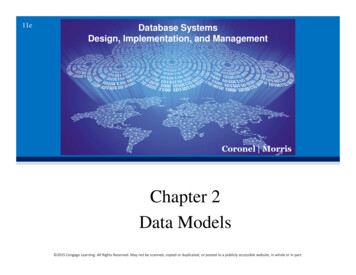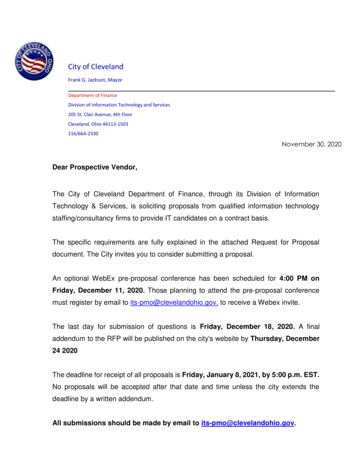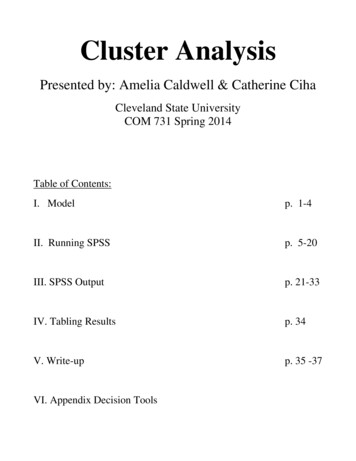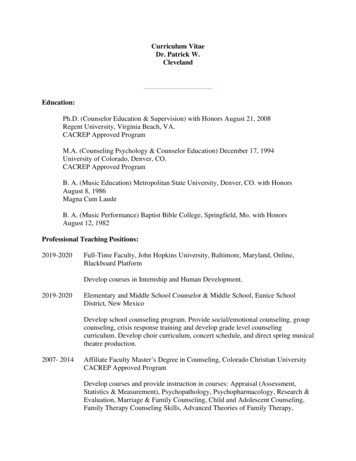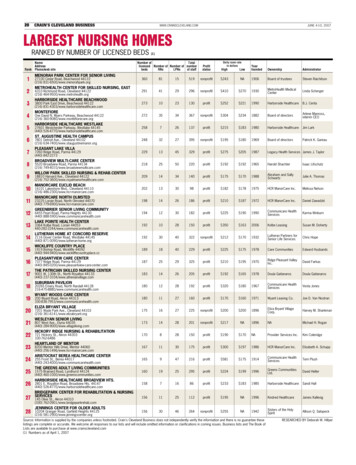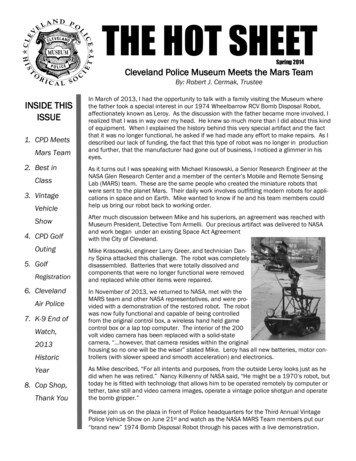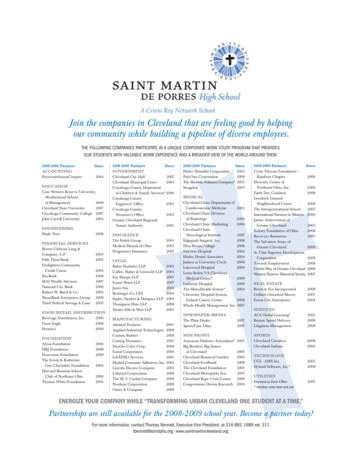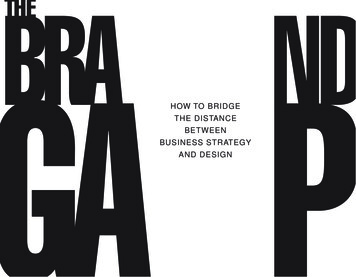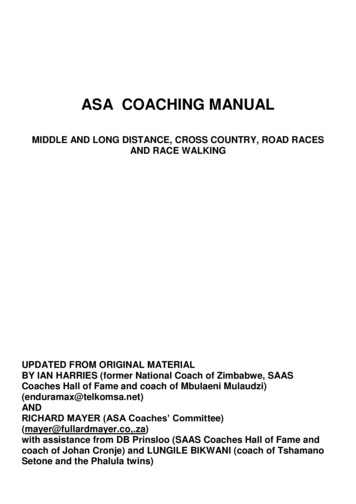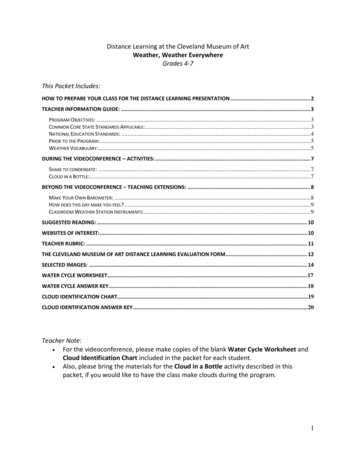
Transcription
Distance Learning at the Cleveland Museum of ArtWeather, Weather EverywhereGrades 4-7This Packet Includes:HOW TO PREPARE YOUR CLASS FOR THE DISTANCE LEARNING PRESENTATION . 2TEACHER INFORMATION GUIDE: . 3PROGRAM OBJECTIVES: .3COMMON CORE STATE STANDARDS APPLICABLE:.3NATIONAL EDUCATION STANDARDS: .4PRIOR TO THE PROGRAM: .5WEATHER VOCABULARY:.5DURING THE VIDEOCONFERENCE – ACTIVITIES: . 7SHAKE TO CONDENSATE: .7CLOUD IN A BOTTLE:.7BEYOND THE VIDEOCONFERENCE – TEACHING EXTENSIONS: . 8MAKE YOUR OWN BAROMETER: .8HOW DOES THIS DAY MAKE YOU FEEL? . 9CLASSROOM WEATHER STATION INSTRUMENTS:.9SUGGESTED READING: . 10WEBSITES OF INTEREST: . 10TEACHER RUBRIC: . 11THE CLEVELAND MUSEUM OF ART DISTANCE LEARNING EVALUATION FORM . 12SELECTED IMAGES: . 14WATER CYCLE WORKSHEET .17WATER CYCLE ANSWER KEY . .18CLOUD IDENTIFICATION CHART .19CLOUD IDENTIFICATION ANSWER KEY .20Teacher Note: For the videoconference, please make copies of the blank Water Cycle Worksheet andCloud Identification Chart included in the packet for each student. Also, please bring the materials for the Cloud in a Bottle activity described in thispacket, if you would like to have the class make clouds during the program.1
How to Prepare Your Class for the Distance Learning PresentationTeacher Information will be sent or made available to you prior to the program.Please familiarize yourself with the materials and discuss them with your class.Have the Teacher Information Packet (T.I.P.) materials on hand in the classroom,ready for the program. These materials may be used during the videoconference.Be prepared to facilitate by calling on students yourself during the lesson.Students are sometimes initially shy about responding to questions during adistance learning lesson.Explain to students that this is an interactive medium and encourage them to askquestions.Reinforce topics discussed in the program by asking students to complete some ofthe suggested pre- and post-conference activities in the Teacher InformationPacket.We ask teachers, after the program, to please fill out the Evaluation Form andreturn it to:Dale Hilton/Distance LearningThe Cleveland Museum of Art11150 East BoulevardCleveland, OH 44106Thank You!2
Teacher Information Guide:Program Objectives:Students will understand The water cycle. How density of air affects weather. Weather changes due to pressure and temperature. Clouds consist of water vapor or ice crystals, depending on their altitude and otherphysical conditions. Different types of clouds are associated with different weather conditions, so visiblechanges in clouds alert one to oncoming weather systems. Cloud types, and their weather systems, have followed consistent patterns for centuries,as documented by both photography and by artwork that predates photography.Common Core State Standards Applicable:English Language Art & Literacy in History/Social Studies, Science, and Technical Subjects4th GradeCCSS.ELA-Literacy.W.4.4Produce clear and coherent writing in which the development, organization, and style areappropriate to task, purpose, and audience.CCSS.ELA-Literacy.SL.4.1Engage effectively in a range of collaborative discussions (one-on-one, in groups, and teacherled) with diverse partners on grade 4 topics and texts, building on others’ ideas and expressingtheir own clearly.5th Grade:CCSS.ELA-Literacy.W.5.4Produce clear and coherent writing in which the development, organization, and style areappropriate to task, purpose, and audience.CCSS.ELA-Literacy.SL.5.1Engage effectively in a range of collaborative discussions (one-on-one, in groups, and teacherled) with diverse partners on grade 5 topics and texts, building on others’ ideas and expressingtheir own clearly.6th GradeCCSS.ELA-Literacy.SL.6.1Engage effectively in a range of collaborative discussions (one-on-one, in groups, and teacherled) with diverse partners on grade 6 topics, texts, and issues, building on others’ ideas andexpressing their own clearly.CCSS.ELA-Literacy.W.6.43
CCSS.ELA-Literacy.WHST.6.4Produce clear and coherent writing in which the development, organization, and style areappropriate to task, purpose, and audience.CCSS.ELA-Litercay.RST.6.3Follow precisely a multistep procedure when carrying out experiments, taking measurements,or performing technical tasks.7th GradeCCSS.ELA-Literacy.SL.7.1Engage effectively in a range of collaborative discussions (one-on-one, in groups, and teacherled) with diverse partners on grade7 topics, texts, and issues, building on others’ ideas andexpressing their own HST.7.4Produce clear and coherent writing in which the development, organization, and style areappropriate to task, purpose, and audience.CCSS.ELA-Litercay.RST.7.3Follow precisely a multistep procedure when carrying out experiments, taking measurements,or performing technical tasks.National Education Standards:(This is a selection of the National Education Standards that align with this program – othersmay apply, as well.)For Science (grades K-4):Earth and Space Science Properties of earth materials Objects in the sky Changes in earth and skyFor Science (grades 5-8):Earth and Space Science Structure of the earth system Water, which covers the majority of the earth's surface, circulates through thecrust, oceans, and atmosphere in what is known as the "water cycle." Waterevaporates from the earth's surface, rises and cools as it moves to higherelevations, condenses as rain or snow, and falls to the surface where it collectsin lakes, oceans, soil, and in rocks underground. The atmosphere is a mixture of nitrogen, oxygen, and trace gases that includewater vapor. The atmosphere has different properties at different elevations. Clouds, formed by the condensation of water vapor, affect weather andclimate.4
Global patterns of atmospheric movement influence local weather. Oceanshave a major effect on climate, because water in the oceans holds a largeamount of heat.The sun is the major source of energy for phenomena on the earth's surface,such as growth of plants, winds, ocean currents, and the water cycleFor Fine Arts - Visual Arts (grades K-4, 5-8): Making connections between visual arts and other disciplines. Choosing and evaluating a range of subject matter, symbols, and ideasFor Language Arts - English (grades K-12): Applying Knowledge Communication Skills Applying Knowledge Developing Research Skills Applying Language SkillsFor Technology - (grades K-12): Basic Operations and Concepts Technology Productivity Tools Technology Communications Tools Technology Research Tools Technology Problem-solving and Decision-making ToolsFor Social Sciences – Geography (grades K-12): Environment and SocietyPrior to the Program: For the videoconference, please make copies of the blank Water Cycle Worksheet andCloud Identification Chart included in the packet for each student. Also, please bring the materials for the Cloud in a Bottle activity described in thispacket, if you would like to have the class make clouds during the program.Weather Vocabulary:Altitude – height as measured in the atmosphere.Altocumulus – cumulus clouds at middle altitudes between 6,000 and 20,000 feet.Altostratus – stratus clouds at middle altitudes between 6,000 and 20,000 feet.5
Barometer – an instrument for measuring air pressure.Collection (accumulation) – the process in which water pools in large bodies (like oceans, seasand lakes.)Condensation – the process in which water vapor (a gas) in the air turns into liquid water.Condensing water forms clouds in the sky.Cirrocumulus – cumulus clouds about 18,000 feet; may also be called “mackerel sky” becauseof their almost shiny silvery appearance, resembling the scales of a mackerel.Cirrus – wispy clouds of ice crystals above 18,000 feet.Cumulonimbus – cumulus clouds that can extend from near the ground to above 50,000 feet;thunderheads that often develop from towering cumulus, and bring thunderstorms.Cumulus - white puffy clouds with distinct edges that sometimes look like cotton balls dotting ablue sky; sometimes have flat bottoms.Density – mass divided by volume.Dew Point – is the temperature at which water vapor can condense into liquid form.Evaporation – the process in which liquid water becomes water vapor (a gas). Water vaporizesfrom the surfaces of oceans and lakes, from the surface of the land, and from melted snow infields.Fog – clouds so low they rest on the ground. Fog that forms in valleys and lowlands is known asradiation or ground fog and may leave the valleys fogged in all day, while the tops of the hillsare clear.Hydrologic – the study of water.Humidity – refers to how much water vapor is in the air.Precipitation – the process in which water (in the form of rain, snow, sleet, or hail) falls fromclouds in the sky.Relative humidity – the amount of water vapor in the air compared to the amount of watervapor the air can hold at a given temperatureSaturation – air reaches the point where it cannot hold any more water.Stratocumulus – layered cumulus clouds below 6,000 feet6
Stratus clouds – long clouds without distinct edges below 6,000 feet; create overcast days.Tornado – rapidly rotating winds blowing around a small area of extreme low pressure thatdevelops within a severe thunderstorm. Often visible as a funnel-shaped cloud, tornadoes candevelop with little or no warning.Transpiration – the process in which some water within plants evaporates into the atmosphere.Water is first absorbed by the plant's roots, then later exits by evaporating through pores in theplant.During the Videoconference – Activities:These activities may be done during the videoconference. The Cloud in a Bottle activity doesrequire you to bring supplies for the class, which are listed below.Shake to condensate:Have students stand at least an arm’s length from each other. While standing they can wiggleand move their arms up and down. When you say Evaporate, they can move about the room,but as soon as they touch someone they have to lock arms, they can still wiggle their free armsuntil they touch another person. Every 10 seconds the teacher can call out “you are higher inthe atmosphere cool off and slow down, and take one step towards the center of the room”.Continue until eventually all arms are locked together. At this point you can call them a cloud(s), and then say precipitate and everyone has to sit down. At this point you can illustrate howeasy it was to move around when they were alone and “low in the atmosphere” with lots ofenergy, but as they got higher in the atmosphere they had to cool down, lose energy, movecloser together and stick just like water molecules forming condensate.Cloud in a Bottle:Materials Inexpensive thin walled plastic water bottle Rubbing alcohol (isopropyl) funnelMethod1. Empty the water bottle and remove the label.2. Place approximately a ½ inch of isopropyl in the bottle and replace the cap.7
3. Swirl the bottle around so the rubbing alcohol touches all parts of the inside of thebottle.4. Quickly twist the bottle in half, around and around as if you were going to twist it apart.5. When the bottle is pressurized and feels like it is going to pop, quickly remove the capand a cloud will form.6. If it doesn’t work here is a video http://www.youtube.com/watch?v VNwZjkqd92YExplanation of why we used isopropyl and not water for the demonstrationIsopropyl alcohol has a lower boiling point than water and alcohol molecules have weakerbonds than water molecules that have very strong hydrogen bonds, so they break more easily.Consequently, isopropyl evaporates more quickly than water. By twisting the bottle, weincrease the energy of the alcohol, as well as the pressure inside the bottle, causing the alcoholto vaporize. Since there are more evaporated alcohol molecules in the bottle, there are alsomore molecules able to condense. When we release the cap on the bottle, there is a rapiddecrease in both temperature and pressure causing the alcohol to condense and form a cloud.Beyond the Videoconference – Teaching Extensions:Make Your Own Barometer:Materials: Coffee or soup Can, balloon, rubber band, pin, drinking straw tape/glue, paper.With the lid off the can, stretch the balloon over the top and put the rubberband aroud it tohelp hold it in place. Tape or glue (not hot glue) the straw to the middle of the balloon, and thepin to the end of the straw. On the paper make an even scale, maybe copy the gradients on aruler. Mark the spot where the pin is pointing, and check the weather report for the airpressure that day. As days go by check your barometer to see if the air pressure increases ordecreases. You can check your results for accuracy by checking the weather report as well.8
How does this day make you feel?(Grades 4, 5, 6)Using the art from the lesson, looking at a picture we can ask the students to write a responseto questions such as: What does that day feel like? What are you doing on this day? Would youwant to be here right now, why or why not? How would the weather in this piece affect yourmood or activities? What phase of the water cycle is represented here? What is the next phase?(Feel free to add in your own questions.)Classroom Weather Station Instruments:For a follow-up assignment, students can design simple meteorological instruments usingcommon household materials, and construct a classroom weather station.With a bit of patience, just a few dollars, and common household items (paper or plasticdrinking cups, human hair, food coloring, drinking straws, modeling clay, masking or duct tape,scissors, etc.), students can build a fully equipped backyard or schoolyard weather stationthat—depending on how carefully and regularly measurements are made—can be surprisinglyaccurate. In addition to helping students become more aware of and observant of weatherconditions on a daily basis, they may discover that conditions in their neighborhood’s localmicroclimate actually differ significantly from those of the nearest official weather station—commonly an airport—just a few miles away.There are several good websites with directions for building backyard weather stations. Checkout more than one site, because they feature somewhat different instruments (you may wantto mix and match), as well as different approaches to their construction.Sites with directions and drawings suitable for upper elementary and middle school grades: The Center for Innovation in Engineering Science and Education (CIESE) site 2/en/activity1.shtml gives simpleinstructions for building a weather vane, a rain gauge, and a barometer. It also includesinstructions for a do-it-yourself thermometer using rubbing alcohol and food coloring,and for an anemometer from paper drinking cups for measuring wind speed.9
Suggested Reading:For students.Weisner, David. Sector 7. New York: Clarion Books. 1999.Duncan, Jim. The Weather Wizard’s Cloud Book. Chapel Hill: Algonquin Books. 1989.Websites of Interest:For students. Test your cloud identification skills with these interactive weather games http://eo.ucar.edu/webweather/ Check out more clouds in art here –https://www.windows2universe.org/art and music/cloud art/clouds in art.htmlFor teachers. Teacher guide to clouds in art site http://www.windows2universe.org/teacher resources/teach cloudart.html A cloud gallery of images free for teachers to use in presentations http://www.carlwozniak.com/clouds/default.html10
Distance Learning at the Cleveland Museum of ArtWeather, Weather EverywhereGrades 4-7Teacher Rubric:Multimedia Project: WeatherTeacher Name:Student Name:CATEGORY4321ContentCovers topic indepth withdetails andexamples.Subjectknowledge isexcellent.Includesessentialknowledge aboutthe topic. Subjectknowledgeappears to begood.Includesessentialinformationabout the topicbut there are 1-2factual errors.Content isminimal ORthere are severalfactual errors.MechanicsNo misspellingsor grammaticalerrors.Three or fewermisspellingsand/ormechanicalerrors.Four misspellings More than 4and/orerrors in spellinggrammaticalor grammar.errors.OralPresentationInteresting, wellrehearsed withsmooth deliverythat rsed with afairly smoothdelivery thatusually holdsaudienceattention.Delivery notsmooth, but ableto hold audienceattention most ofthe time.Delivery notsmooth andaudienceattention lost.11
The Cleveland Museum of Art Distance Learning Evaluation FormYour NameYour SchoolSchool Address (with zip code)E-mail AddressGrade/Class of students (e.g. 10th grade French)Program TitleProgram DateThank you so much for your participation in our distance learning program. We would appreciateyour response to these questions by circling the appropriate answer and returning the survey.Please Mail or Fax to Dale Hilton at 216-707-66795 Strongly Agree2 Disagree4 Agree3 Neither Agree nor Disagree1 Strongly Disagree1.The teacher information packet was helpful for preparing my class and me for the distance learninglesson.543212.The teaching style of the on-camera instructor was interesting, engaging and fostered interaction.543213.The Teacher Information Packet was helpful in providing interdisciplinary extension activities that Idid use or plan to use.54.143214321The pre-requisites the distance learning lesson and extensions are aligned with The NationalEducation standards.57.2The distance learning lesson was not interrupted by technical difficulties
For the videoconference, please make copies of the blank Water Cycle Worksheet and Cloud Identification Chart included in the packet for each student. Also, please bring the materials for the Cloud in a Bott
